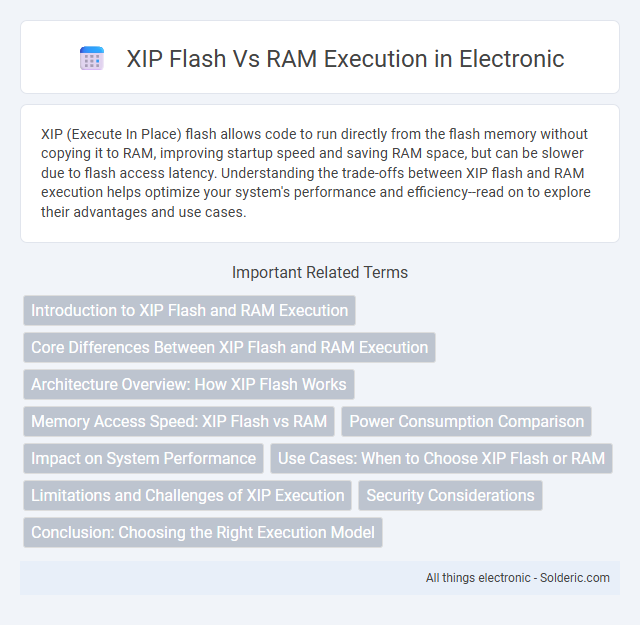XIP (Execute In Place) flash allows code to run directly from the flash memory without copying it to RAM, improving startup speed and saving RAM space, but can be slower due to flash access latency. Understanding the trade-offs between XIP flash and RAM execution helps optimize your system's performance and efficiency--read on to explore their advantages and use cases.
Comparison Table
| Feature | XIP Flash Execution | RAM Execution |
|---|---|---|
| Definition | Execute code directly from external or internal flash memory. | Copy code into RAM and execute from faster volatile memory. |
| Execution Speed | Slower due to flash latency and bus speed limitations. | Faster, benefits from low-latency RAM access. |
| Power Consumption | Lower overall, as no RAM copying needed. | Higher, due to additional RAM activity and copying overhead. |
| Memory Usage | Saves RAM space, uses flash memory directly. | Consumes additional RAM for code storage. |
| System Complexity | Simpler boot process, no code copying required. | Needs initialization routine to copy code to RAM. |
| Use Cases | Suitable for large, infrequently updated code segments. | Ideal for performance-critical or frequently executed code. |
| Reliability | Less sensitive to RAM corruption. | Dependent on RAM stability. |
| Cost | Lower cost due to reduced RAM requirements. | Higher cost due to increased RAM size. |
Introduction to XIP Flash and RAM Execution
XIP (Execute In Place) flash execution enables programs to run directly from non-volatile memory without copying to RAM, reducing RAM usage and speeding startup times. RAM execution involves loading code into volatile memory for faster access and execution but requires additional memory resources and longer initialization. This comparison highlights trade-offs in system design between efficient memory utilization and execution speed.
Core Differences Between XIP Flash and RAM Execution
XIP (Execute In Place) flash execution reads and runs code directly from non-volatile flash memory, saving valuable RAM space while potentially incurring slower access speeds and increased latency compared to RAM execution. RAM execution involves copying code into volatile memory before running, offering faster access times and improved performance at the expense of higher RAM usage. Understanding these core differences helps optimize your embedded system's memory usage and processing efficiency based on application demands.
Architecture Overview: How XIP Flash Works
XIP (eXecute In Place) flash allows the CPU to run programs directly from the non-volatile flash memory without copying code to RAM, reducing memory usage and boot time. In XIP architecture, the flash memory is mapped into the processor's address space, enabling instruction fetches to occur directly from flash with minimal latency. This approach improves system efficiency but requires flash memory with fast random access capabilities and instruction caching to maintain performance comparable to RAM execution.
Memory Access Speed: XIP Flash vs RAM
XIP (Execute In Place) flash provides slower memory access speed compared to RAM due to its non-volatile storage technology and longer read latency. RAM offers significantly faster access times, enabling quicker data retrieval and improved execution performance for your applications. Choosing between XIP flash and RAM execution depends on balancing speed requirements with storage and power efficiency.
Power Consumption Comparison
Executing code from XIP flash significantly reduces power consumption compared to RAM execution by eliminating the need for extensive data copying and reducing high-frequency memory access. XIP flash leverages non-volatile memory technology that maintains data without continuous power, resulting in lower active and standby power usage. In contrast, RAM requires constant power to retain data and higher energy for frequent read/write cycles, leading to increased overall power consumption during execution.
Impact on System Performance
Executing code directly from XIP flash reduces RAM usage but often results in slower access times compared to RAM execution, impacting overall system performance. RAM execution offers faster instruction fetch and data access speeds, enhancing real-time responsiveness and throughput in performance-critical applications. Systems balancing memory constraints and speed requirements must optimize code partitioning to maximize efficiency and maintain acceptable performance levels.
Use Cases: When to Choose XIP Flash or RAM
XIP (eXecute In Place) flash is ideal for applications requiring low memory usage and fast boot times, such as embedded systems or IoT devices with limited RAM. RAM execution suits high-performance tasks needing frequent code modification or faster access speeds, like real-time processing and complex algorithms. Choosing between XIP flash and RAM depends on balancing memory constraints, execution speed, and update flexibility for the specific embedded application.
Limitations and Challenges of XIP Execution
XIP (eXecute In Place) flash execution faces limitations such as slower access speeds compared to RAM, leading to increased latency and reduced overall system performance. Flash memory's limited wear endurance restricts frequent code updates, posing challenges in dynamic or frequently updated applications. Additionally, XIP execution can complicate real-time operations due to unpredictable flash access times and limited random access capabilities.
Security Considerations
Executing code directly from XIP flash enhances security by reducing the attack surface associated with RAM, as code in flash is typically immutable and less susceptible to tampering or injection attacks. RAM execution poses higher risks due to its volatile nature, allowing malicious code modifications during runtime and easier exploitation through buffer overflow or code injection vulnerabilities. Employing XIP flash execution strengthens code integrity and resilience against unauthorized alterations, crucial in embedded systems requiring robust security measures.
Conclusion: Choosing the Right Execution Model
XIP flash execution offers faster startup times and reduces RAM usage by running code directly from non-volatile memory, making it ideal for memory-constrained embedded systems. RAM execution provides higher performance and lower latency, benefiting applications that demand rapid data processing and frequent memory access. Assessing your system's memory capacity, performance requirements, and power consumption helps determine the optimal execution model for your embedded application.
XIP flash vs RAM execution Infographic

 solderic.com
solderic.com